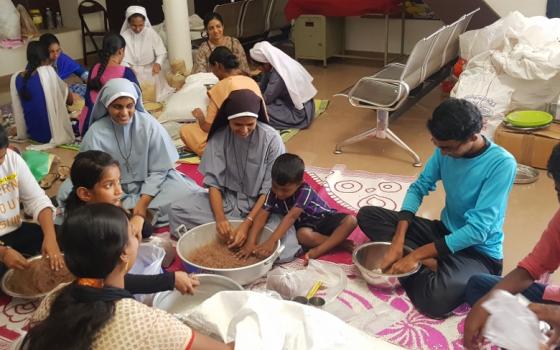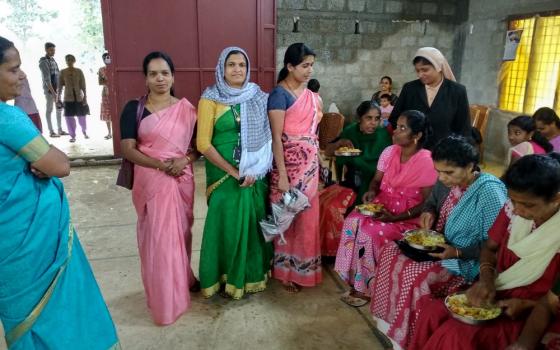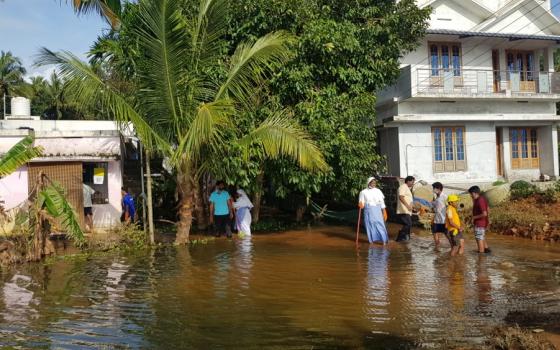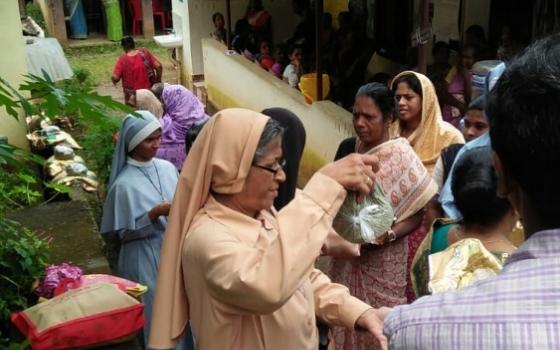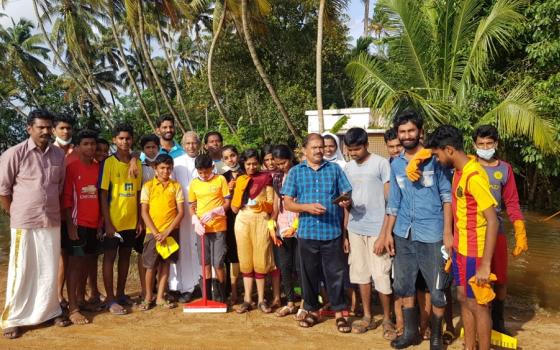More than 6,700 Catholic nuns are among those helping over a million people taking shelter in relief camps after unprecedented floods ravaged Kerala, a southwestern Indian state.
"This is the biggest rescue and relief operation the Catholic Church in Kerala has undertaken in its history," says Fr. George Vettikattil, who heads the church's relief operations in the state.
The church deployed its personnel and opened its institutions across Kerala to help people after rains and massive floods devastated 13 of Kerala's 14 districts from Aug. 15 through Aug. 20. The rain has stopped in many places and water is now receding.
Kerala Chief Minister Pinarayi Vijayan on Aug. 24 told the media that the rains and floods have claimed 417 lives. At least 36 people are still missing.
The floods initially displaced nearly 1.3 million people. About 869,000 people were still sheltered in 2,787 relief centers in the state, Vijayan said.
The initial estimated loss was around 200 billion rupees ($2.85 billion).
Catholic aid agencies such as Caritas India are now working among the flood victims. Caritas India has already spent about 6.1 million rupees ($87,140) distributing food, medicine and sanitation items. Its director Fr. Paul Moonjely says the agency plans to raise another 10 million rupees.
Vettikattil says all 32 Catholic dioceses in Kerala have joined relief works. As many as 69,821 young people and 99,705 lay volunteers joined 6,737 nuns, 2,891 priests and 354 seminarians to rescue stranded people with the help of government agencies and individually, the priest told Global Sisters Report.
The church workers, especially nuns, take care of all the needs of the camp residents, Vettikattil says. "Sisters play a pivotal role in taking care of the elderly, children, and the sick very specially," he adds.
Sister Modesta, secretary of the Kerala unit of the Conference of Religious India, says all 30,903 women religious from 349 congregations in Kerala have joined the rescue and relief operations from the beginning.
The state also has 2,178 religious priests and 447 brothers who have also joined in helping the flood affected.
"We have formed separate groups comprising priests, nuns and brothers to clean the mud from houses of people living in relief camps," Sister Modesta, who is a member of the Congregation of Teresian Carmelites, told GSR. "They leave in the morning and work until evening," she added.
Many nuns, such as Sr. Anju Sebastian, are appointed by the government as counselors in relief camps. Sebastian, a member of the Daughters of Sacred Heart of Jesus who is based in Nedumkandam, a town in the Idukki district, says her biggest challenge is people's reluctance to return home.
"The traumatized people who have seen their neighbors and relatives being washed away in landslide or killed in soil erosion do not want to go home," she told GSR.
She has so far visited 15 relief camps to counsel people, most of whom are farmers, crossing broken roads and flooded streams on foot to get to them.
Another counselor, Sister Chaithanya of the Congregation of Mother of Carmel, says they walk several miles daily to encourage people to face the reality and move forward.
"Many have not reconciled to the death of their relatives, loss of houses and sources of livelihood," she told GSR.
Many are dejected since they could not attend the funerals of relatives and friends as floods snapped transport and telecommunication infrastructure in Idukki, a hilly region.
"The hills have developed big cracks, and walking on such areas has become dangerous," Chaithanya said. The region has seen a recent phenomenon of houses and soil caving in. "People are afraid to go back from relief camps," she added.
Sr. Ruby Thomas, also a Daughter of Sacred Heart of Jesus, along with 17 other sisters from her congregation, managed to accommodate 3,000 people in eight relief campus in Kottayam district. "We arranged everything such as food, clothes, brush, paste, medicine and other things," she told GSR. "Special care was given to the sick, elderly and children," she added. The nuns now try to motive those in the camps to start life anew.
"It is true that everyone came empty-handed not knowing what was ahead," says Sr. Lincy Valiyaplackel, a member of the Adoration of the Blessed Sacrament, who works at a camp for 500 people at St. Teresa's Higher Secondary School, Vazhappally, near Changanacherry in Kottayam district.
She says 24 members of her congregation now manage three relief camps around Changanacherry along with nuns from other congregations.
Changanacherry, a Christian stronghold, has total 32 camps with 50,000 displaced people. A battery of 300 nuns from 14 congregations is engaged in marathon-style counseling sessions for them, says Sr. Litty Kochuchira, head of the Devamatha province of the Franciscan Clarist Congregation in Changanacherry.
"When they return, many will have no house. It could lead them to depression and even suicides," Kochuchira told GSR. "We counsel them to accept what has happened while assuring them that the government and aid agencies would help them build new houses," she added.
One resident of the Vazhappally camp is Shyam Lal, an air conditioning mechanic who had come for holidays from Dubai. "I was in a hospital with my sister and nephew when the floods came. I thought it was my end," recalled Lal, a Hindu who lived in a rented house with his wife, child and parents in Chambakulam in the Alappuzha district that was submerged in water.
As the hospital flooded, he and his sister and nephew moved to a safer location, and they ended up spending a night in a bus stand before being taken to a relief camp. As telecommunications failed, he couldn't contact his parents, wife or child. He said he met them three days later at the Vazhappilly camp.
"We were saved from the mouth of death. This is a new life for us," he told GSR. They have only the clothes they were wearing — everything else was lost, he said.
Counseling by the nuns in the camp "helped me accept the loss and look forward for a bright future although I have no idea where I would go," he said as he prepared to entertain the camp. "We organize a folk dance and singing competition every evening to forget our loss and get rid of our depression," he said.
Those in the camp now live like a family even though they come from different religions and social background, he said. "We have the same reason to cheer as we are alive despite losing everything," he explained.
Valiyaplackel says the nuns engage the people in various activities to help them forget their losses. "They have to cope with the loss and gradually muster the courage to face the challenges ahead like Lal," she said.
Kochuchira says she finds humanity "very much alive" in the camps. "The calamity has made the poor and the rich queue up for food and clothes, forgetting their social status. Here people eat, sleep and spend time together under one roof," she pointed out.
Kochuchira is also impressed with outsiders coming with food and clothes for the people living in the camps. "Everyone shares God's love here," she added.
Sudharma Uthaman, a Hindu mother of two grown children who lived in a two-room house in Kuttanad region near Changanacherry, applauded the nuns' services. "When I came to the camp, I was sad, as I lost everything. Now we are happy that we are alive."
She and others from her village were brought to the camp in a boat. "As soon as we reached the camp, we got a warm welcome with tea. The nuns also offered us clothes and facilities to bathe," Uthaman told GSR.
Kochuchira foresees a danger, though — traffickers.
"Calamity is a time people tend to fall into traps set by human traffickers," she explained. She said they have come across reports of children of calamity-struck families getting enticed with offers of jobs and opportunities to study overseas. "We have asked people to be extremely vigilant," she added.
[Saji Thomas is a freelance journalist based in Bhopal, a central Indian city. He has worked for several mainstream newspapers such as The Times of India. This article is part of a collaboration between GSR and Matters India, a news portal that focuses on religious and social issues in India.]
